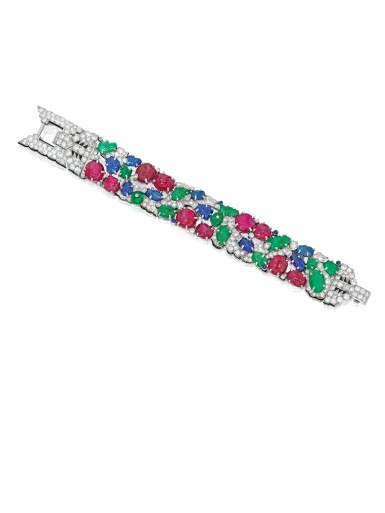
GEM-SET, DIAMOND AND ENAMEL 'TUTTI FRUTTI' BRACELET, CARTIER
Lot Closed
April 28, 02:01 PM GMT
Estimate
600,000 - 800,000 USD
Lot Details
Description
Property from a Distinguished American Collection
GEM-SET, DIAMOND AND ENAMEL 'TUTTI FRUTTI' BRACELET, CARTIER
Designed as meandering vines, set with old European and single-cut diamonds, featuring carved emeralds, rubies and sapphires, accented by emerald beads, cabochon sapphires and emeralds, highlighted with calibré-cut onyx and black enamel, length 7 inches, signed Cartier, numbered 1604; circa 1930.
For a bracelet of similar design, see Cartier: Jewelers Extraordinary (1984 edition), Hans Nadelhoffer, color plate 44.
"Never copy, only create." This mission statement, embraced by brothers Louis, Pierre and Jacques, yielded jewels of extraordinary originality and beauty, propelling Cartier to never-before-seen levels of global success in the early twentieth century. During this period, the firm was well-known for taking inspiration from the "exotic," but nowhere was this more masterfully expressed than in their tutti frutti jewels.
Cartier's first foray into the style was a necklace for Queen Alexandra who, as the wife of King Edward VII and by extension Empress Consort of India, commissioned a piece to complement three Indian-style dresses. Ten years later, in 1911, Jacques ventured to India where he amassed a vast collection of carved colored stones which he employed in a further refinement of the style, taking advantage of recent advancements in the manipulation of platinum. After being exhibited at the 1925 Exposition Internationale des Arts Décoratifs et Industriels Modernes in Paris, tutti frutti jewels rapidly gained popularity among the most fashionable and discerning collectors of the day, including Mrs. Cole Porter and Daisy Fellowes.
Cartier produced a variety of tutti frutti jewels and objects, both for stock and special-order, with bracelets being the most sought-after form. All pieces share the hallmark of Mughal-cut colored stones, but each piece is unique, a variation on a captivating theme. The present lot is distinguished by the vibrancy of its gemstones-with rubies predominating-and by the lines of black enamel, placed intermittently along the trim of various elements. The enamelwork is applied to just one side-a particularly clever flourish-echoing the organic asymmetry of the foliate elements. The bracelet returns to a more traditional Art Deco aesthetic with its pavé-set diamond clasp, highlighted by onyx triangles and chevron-shaped closures. The overall design, and execution, is unmistakably Cartier.
Sotheby's is honored to present this iconic jewel, created almost a century ago, via a thoroughly modern platform. Never copy, only innovate.
